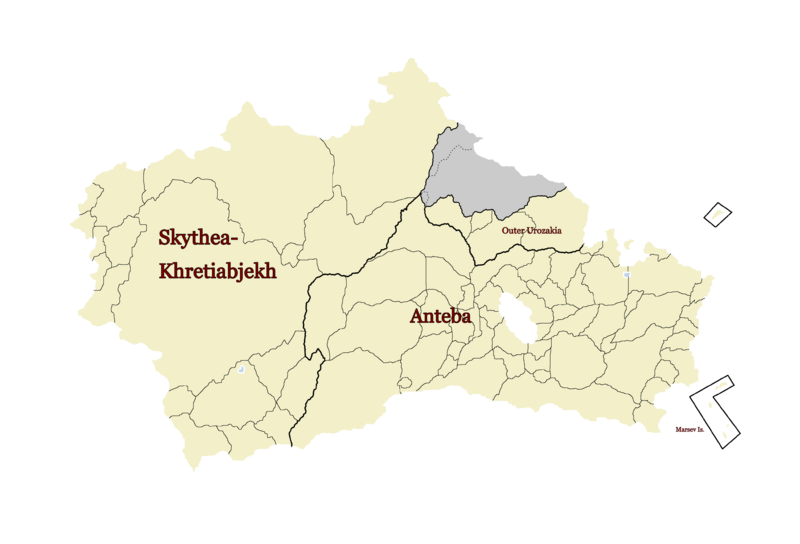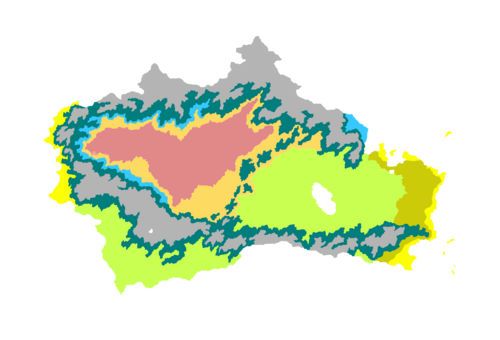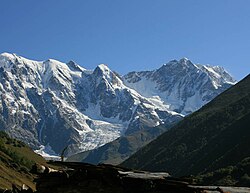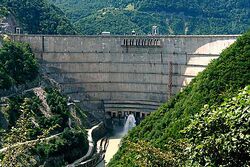Encessia
The Auteker of Encessia ენცეზია | |
|---|---|
Motto: "ღმერთმა დაიცვას ჩვენი ერთიანობა" God preserve our unity | |
Anthem: “მაღალმთიანთა ერი” | |
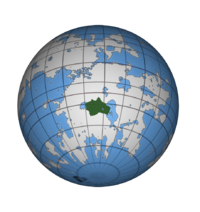 Location of Encessia in Thrismari | |
| Capital | Samepo |
| Largest city | Potia |
| Official languages | Encessi |
| Recognised national languages | Skythean, Urozakian |
| Recognised regional languages | Abjekh, Arabic |
| Ethnic groups (c. 2020) |
|
| Religion |
|
| Demonym(s) | Encessian |
| Government | Constitutional Dictatorship (Auteker) |
• Autek | Aleksandre Beridze |
| Establishment | |
• Unification of Skythea and Anteba | ab. 700 AD |
• Conquest of Urozakia | ab. 800 AD |
• Dissolution of the Kingdom of Anteba | 1890 |
• Formation of the First Republic | 1927 |
• Autekrat control and dissolution of the First Republic | 1989 |
• Establishment of the Auteker | 1994 |
| Population | |
• 2018 census | 62.2 million |
• Density | 92.4/km2 (239.3/sq mi) |
| GDP (nominal) | 2018 estimate |
• Total | 1.0 trillion ACU |
• Per capita | 16,077 ACU |
| Gini (2018) | low |
| HDI (2020) | very high |
| Currency | cenka (ц) |
| Time zone | GMT-2, GMT-3 |
| Driving side | right |
| Calling code | +77 |
| Internet TLD | .en |
Encessia (Encessian: ენცეზია, romanized: "Entsezia") is a country located in central Thrismari. It is bounded to the east by the Marmor Sea, and bordered by Abjekistan to the northwest and South Eissenau to the south. The capital is Samepo, and the largest city is Potia. Its population is about 62.2 million, and is ruled by a limited dictatorship with military authority. Encessia is a popular tourist destination due to its extensive and old history, known for its medieval castles, beautiful natural mountains, and ancient wine and culinary traditions. It is popular with foreign nations for its copper and lithium production, accompanied with a healthy oil industry and large agriculture sector mainly focused in the south.
During the classical era the main force to dominate the Encessian highlands were the Skytheans, an ethnic group and national identity that spoke Skythean, a member of the Kartvelyn language family. They conflicted with their northern neighbors, the Urozakians, before the Skytheans overran their land and integrated them into the loose empire. By 200 AD the Skythean empire stretched across the deserts and steppes of central Thrismari, and raided its neighbors to maintain itself- and integrated into surrounding nations to expand the Skythean culture and influence. In about 600 AD Encessians migrated into the highlands from the south after being exiled from modern-day South Eissenau by Germanic counterparts. They settled along the fertile valleys and foothills of the Narinjisperi mountains, and soon had established their own nation known as classical Anteba. The Skytheans had attempted to subdue and assimilate the Encessians, but in the following wars they were driven back into the Hilajhi Basin by the Encessians who utilized advanced methods of metals and metalworking. As Skythea fell from power the kingdom of Anteba would take its place, establishing itself as the dominant power of the region into the Middle Ages. Under King Abramishvili the kingdom of Anteba would begin military conquests against the rump Skythean state and Urozakia to the north, bringing them under the banner of Anteba around 1198-1207 and establishing his empire. Anteba would reach the peak of its power and prosperity around this time, becoming a dominant power in central Thrismari and being home to many advancements and revolutions during the Middle Ages. It is thought Encessia's power reached its highest under King Abramishvili IV in 1311 which hosted the beginning of an explosive golden age that followed for years after.
It wasn't until 1887 that the Kingdom would fall after years of oppressive leadership, stagnation, and increased nationalism among the minority groups of the nation. In 1890 Encessia would dissolve into the states of Khretiabjekh, Skythea, Urozakia, and Anteba once more. Only in 1927 did a Republic form between the separate entities, dominated by the Encessians who outnumbered the other ethnic groups greatly. The Republic however was weak, and failed to provide stability or modernization. Despite these insecurities the Republic still went on to occupy and seize the Marsev Islands from their Qazhshavan overlords in 1933 in an effort to expand industry on new fronts and better project regional power. In 1977 a group known as the 'Autekrats' assumed political majority in the Republic, and under their authoritarian yet progressive ideals they spurred the nation forward to the modern world- but conflicted with the Left Republicans and Monarchists both. In 1989 the monarchists attempted to overthrow the Republic, starting a civil war that would last for four years. The Autekrats and Left Republicans allied to fight back the Monarchists, and concluded the war with victory in their favor. However with majority support of the people the Autekrats declared the dissolution of the First Republic, which antagonized the Republicans who soon after attempted a coup of their own that was swiftly crushed. Autek Beridze rose to power, a famous and experienced general from the war, and established a constitutional dictatorship in an action of emergency. Placing the Autekrats in power to this very day. Encessia is a developing country, with a 'very high' HDI of 0.865.
Etymology
The word Encessia quite literally means "land of the Encessians" in the dead Anteban dialect of Encessian. The first usage of Encessia stems from the Skythean word for wolf, Uncez. In the classical ages Anteba was referred to by the Skytheans as Uncezia, meaning "land of the wolves". Later Urozakians also began to refer to Anteba as this name, and medieval Urozakian geographer was one of the first to accurately map central Thrismari and when doing so bestowed Anteba the name Uncezia. The first wide foreign usage of this name would follow, and after the unification of the Kingdom the Anteban dialects would assimilate both Urozakian and Skythean elements and form the modern version of Encessia. In these dialects Uncezia slowly changed to Encessia over the years. The first spelling of Encessia can be found in Kentalian explorer Vlado Hristov's maps of Thrismari after he inquired the locals on the name of their kingdom. In 1927 after the dissolution of the Kingdom and the establishment of the First Republic Anteba was modernized and referred to as Encessia as a more true term for the three states that made up the nation, officially installing the name of Encessia.
History
Government and Politics
Encessia is a hybrid dictatorship, with the Auteker as the head of state and government. The executive branch of power is made by the Auteker and his counsel appointed by his own choice, with representatives for every aspect of the Encessian nation that includes ministers of Defense, Economy, Culture, Internal Affairs, Diplomacy, and Education. Legislative power is also invested in the Autek and his counsel, though with the aid of many appointed sub-advisors and ministers. Aleksandre Beridze is the current Autek after taking power in 1994. The Auteker is compelled to guarantee civil liberties and follow the laws of its constitution, a satvaltvalo is elected by the people as a representative of their liberties and the main independent enforcer of the constitutional law.
The only party in control of the government is the Autekrat party, generally divided into two seperate factions: White Autekrats and Gray Autekrats.
While civil liberties are well guaranteed, political freedoms in Encessia have been relatively low since the dissolution of the First Republic. Encessia is classified as a 'partly free' nation.
Encessia is a unitary system, headed mostly by a small state government get representation does exist for each sakhel. Each sakhel is headed by an elected governor who acts on that sakhel's behalf. Even further down from the sakhel level is the local level, where each sakhel is divided into kalaki. A kalaki consists of a capital town, city, or township and the surrounding area and is headed by an elected tavmjdomare. In early 2021 the state government announced the opening of elections for sakhel governors and the future formation of a legislative branch in what Autek Beridze described as 'a slow transition into a powerful and responsible democracy'.
Parties
Military and Police
Encessia's armed forces are divided into land, air, and naval forces. They are collectively known as the Encessian Defense Forces (EDF). The missions and powers of the EDF are described in the Autekrat constitution introduced in 1994, tasking them with the simple duty of 'ensuring the integrity and safety of Encessia, and her interests'. This along with treaties and other pacts the nation may become or be signatory to. The total budget for the EDF amounts to around 121,765,800,000ц (32,500,000,000 ACU), in 2019 with a 6% increase since 2017. More than half of the budget is spent on maintaining quality and potency of the forces, as opposed to rapid expansion. Since the establishment of the Auteker in 1994 Encessia has rapidly expanded its military industry to remove reliance on foreign powers. State-owned arms company Sabrdzolo Masala Potia is responsible for the manufacture and design of most Encessian arms, along with their exports across Anteria of mainly in artillery and small arms.
The military is administrated by the Ministry of Defense, headquartered in Samepo. Land forces are further divided into the State Police (ESPD), Encessian Ground Forces (EGF), and the Internal National Guard (ING). The ESPD serves as the domestic peacekeepers in the internal civilian sphere of Encessia, responding to criminal activity and maintaining the well being and security of Encessia's people. The EGF serves as the main land operated force of the Auteker, dealing in global deployments and war efforts usually externally. The ING operates as the garrison force of Encessia, usually tasked in dealing with internal military threats or the handling of high-interest areas or domestic threats.
Encessia maintains a mainly coastal based navy centered on small ship fleets with capital cruisers. There are two divisions within the navy, the Encessian Coastal Fleet Command (ECFC) and the Capital Deep Sea Division (CDSD). The ECFC remains far larger, and operates within a specified range extending across the Marmor Sea and from a select number of coastal bases in Potia and Shervali. The ECFC maintains the maritime defense of coastal areas and the defense of trade access. The CDSD maintains one capital fleet, and deals with far international naval missions when needed.
Encessia also organizes a national air force classified under one division- the Encessian National Air Force (ENAF). This classification encompasses the entirety of the air forces in Encessia, both internal and international. The ENAF is mainly equipped to deter enemy air superiority and provide close air support for ground or naval forces.
Law Enforcement
Administrative Divisions
Geography
Most of Encessia is situated in the plateaus and highlands between the southern Narinjisperi mountains and the northern Godriji mountains. It is a very mountainous and rugged country. Divided down the middle by the Lewle Range are two regions commonly referenced to as Anteba-Urozakia and Skythea.
The fringes of the Godriji form Encessia's northern border, with few road and railroad connections passing through their massive peaks. The southern border of the nation is determined partly by the slightly smaller Narinjisperi range and the wide Kukhili River. Both mountain ranges sport peaks that rise more than 18,000 feet (ab. 5,500m) above sea level, and have historically served as strong natural barriers in protection of the nation.
The highest peak in Encessia is Shavinis T’akht’i at 21,125 feet (ab. 6438.9m) and the second highest is Mount Zaur at 20,987 feet (ab. 6396.8m), other prominent peaks including Mount Zsiuri at 19,998 feet (ab. 6095m) and Didi Mts’vervali at 19,887 feet (ab. 6061m).
The term Anteba is generally used to describe the lush southern plains north of the Narinjisperi mountains and east of the dividing Lewle range. Characterized by large amounts of rainfall and river access and relatively stable elevation. It can be further divided into the Mshvidobiani region, the eastern portion with coast along the Marmor sea and fair Mediterranean weather, and the region of Imedi to the west, an area of inland plains and the foothills of the Lewle Range. Due to habitation both regions are the most populated and economically active in the nation. The wide Q’viteli and Temo rivers and their tributaries run through the area as abundant accesses of water, and flow in and out of the Lake of Konstantyne in central Imedi.
North of Anteba is the Urozakia Plateau situated west of the Godriji mountains. It is an area of elevated land on the Shavyn Incline bordered by the Lesser Godriji to the west and the Marmor Sea to the east. It generally has a cold semi-arid or highland climate- and is excessively rugged in terrain. The Plateau's dry weather and jagged build leaves the area sparsely inhabited. Rivers are not common- with aquifers being the main bodies nestled in the deep and winding caves of the area thanks to an ancient volcanic past. Tamaris Ts’armoshoba is recorded as the deepest cave in Anteria at 2,230 meters. Urozakia is further divided into two regions, the larger of the two being the like named Urozakia Plateau and the area's coastal land named the Khukili Coast known commonly for a hot semi-arid climate and a high shoreline frequented by storms.
West of Anteba and Urozakia is a region known as Skythea. Divided into three areas: the Hilajhi Basin, Khizuzis Sanap’iro, and Tariela. The Hilajhi Basin refers to the geographical depression flanked by the joining of Godrigi and Narinjisperi mountains and the Lewle range. The Hilajhi Basin also contains the Hilajhi Desert- a very arid region that receives little rainfall thanks to the mountains surrounding it. Compared to the rest of the nation the Hilajhi Desert is relatively flat, and regional areas are able to support farmland along the banks of the Abraamilli River. Khizuzis Sanap’iro refers to the mild weathered coast along the Khizuz Sea, a body of water shared to the west by Abjekistan. Tariela is the name of the southern temperate plains at the southern bases of the Narinjisperi that remain relatively isolated from the rest of the nation thanks to the natural barrier. Northern Skythea tends to be comprised completely of the Godriji and their highland climate.
Topography
The landscape within Encessia varies greatly. Encessia's landscapes can range from highland tundras to rocky deserts.
Much of the nation's natural habitat has slowly receded in areas thanks to rapid urbanization and agricultural development. The massive forests that once covered the Anteban plains are now much smaller or reduced to nothing save for those protected by the extensive national parks. National parks that the state government puts heavy emphasis on preserving. Presently forest cover tends to remain outside of populated low-lying areas and around mountains or foothills. Mideastern Encessian forests tend to be comprised mostly of deciduous trees and contain species such as oak, hornbeam, elm, and ash. Evergreen species also grow well in the given climates.
Far eastern coastal Encessia sports a Mediterranean climate. Warm and dry mild weather along the Marmor Sea's coastline with colder variants further inland. This area tends to be characterized by picturesque shoreline low in altitude and a hilly terrain. Plant life tends to be comprised of low shrubbery and evergreens further inland while becoming notably denser near the wetter coast. Rainfall barely exceeds 900mm per year, due to a rain-shadow effect caused by the Lesser Narijinsperi which hook up and through the area and divide coastal Mshvidobiani with inland Imedi.
Northern Encessia is dominated by the climates of the large Godriji Mountains. Which tend to vary in overall climate depending upon elevation. Dense evergreen forests may hug the lower bases while permafrost tundras remain at the highest peaks, forever snow-capped. Small glaciers even exist in the highest parts of the Godriji.
Western Encessia is comprised of cold semi-arid and cold desert climates surrounded by the shadowing mountain ranges of the nation. These areas rest mostly within the low lying Hilahji basin. An area that tends to be comprised of arid shrub-lands and low vegetation across rolling plains, periodically interrupted by geographical rocky formations and variations. Plants rarely exceed 2.5 meters and include species such as cork oak and bur sage. Further into west-central Encessia the steppe climate gradually transitions into a dryer cold desert climate. Central Hilajhi is covered in sanded desert with patches of vegetation growth. This area of Encessia receives the smallest amounts of annual rainfall, usually less than 51mm.
Biodiversity
Encessia is home to a very diverse range of fauna thanks to its many climates and fair latitude. It is home to about 6,345 species of animals, most being endemic. Its
deserts, forests, and mountains are inhabited by many apex predators such as brown bears, lynxes, wolves, and Anteban Leopards. The Encessian Longfur Sheep (the nation's national animal, the male variant), and the common pheasant (sometimes called the Skythean Pheasant) are native to Encessia and were introduced to the remainder of Anteria as herding and game animals, respectively.
The water bodies of Encessia are also home to hundreds of species of fish, and the endangered Imedi Red Beaver. Areas that are placed under heavy protection after a sharp decline in marine life in the 1980s following rapid industrialization and growth.
Encessia has a 2018 forest landscape integrity index (FLII) mean score of 8.95/10.
Economy
Archaeological research in Encessia has shown signs of commerce and activity dating back many years. Even before the formation of the first kingdoms inhabitants of the area embarked in regional trade systems as far as the edges of Thrismari. The Marmor Sea had historical significance as a lifeline of connection and commerce for ancient Encessia, still being an important outlet to this day. It is believed that Encessia is the oldest producer of wine in Anteria, an industry that still remains a very important part of the Encessian economy. Over the past years Encessia's economy had been reliant on tourism and agriculture, though in the recent 21st century the nation has rapidly grown and developed a industrial sector that supports a strong economy.
Since 1927 with the declaration of the First Republic Encessia had an almost complete command economy controlled by the government in efforts to facilitate its growth. Throughout most of the 20th century Encessia had a stagnant and sometimes declining growth in relation to the rest of the world. After a severe economic crash in 1979 that sent the country down the clutches of instability, the Autekrat seize of economic powers in 1986 saw massive growth in the economy of the nation. The civil war (1989-1994) caused a dip in this growth, but the reconstruction years following would lead Encessia to have one of the fastest growing economies in the world. The Autekrat reforms had introduced a free market that encouraged the expansion and investments of private corporations which own much of Encessia's industries. They also improved tax collection and introduced a flat income tax rate, which expanded the government reserves to further growth and improvement.
Encessia has secured a position in international commerce, becoming a gateway within the Marmor Sea for inland Thrismarian trade into countries such as Abjekistan. The ports of Potia and K'arbechilli are some of the largest in the region, and serve as the commercial centers of the nation. Railroads through the Godriji and Narijinsperi Mountains have improved international land transportation through previously inaccessible areas, along with internal transportation. Oil and gas lines run through the Marmor and Khizuz seas.
Encessia's imports include mainly electronics, machinery and parts, automobiles, and pharmaceuticals. The nation exports copper, lithium, agricultural products, and textiles. Along with these exports is a generous power production sector. Power lines run throughout the nation, and over borders to neighboring areas. Power production in Encessia comes from natural gases and oil extracted from reserves in the Godriji declared to be only utilized by internal Encessia, while a large portion (39.8 percent) comes from hydroelectric power.
In 1999 57 percent of Encessians lived below the national poverty line, in 2009 this number had sharply decreased to 27 percent, and by 2019 it fell ever further to a mere 6 percent. By 2019 average houshold income in Encessia was 27,900ц (7,420 ACU).
Agriculture
Agriculture in Encessia remains one of the most important aspects of the economy. Almost a quarter of all land is used for crop growth, while around twenty percent is used for livestock grazing- and usually both at once. Encessia is an exporter of many fruits such as grapes, citrus fruits, and pomefruits all grown in eastern and far western Encessia. In central fertile plains products such as maize, potatoes, wheat, and soybeans are grown en masse. Ranching is common in Skythea, mainly beef and mutton is produced in these areas. Encessia has a heavily subsided agriculture sector, overseen by the government based Agrarian Department. Since 1997 the Auteker has placed restrictions on private sales to first meet the national demand of production before export sales are permitted for specific products. Usually these parameters are met, and much of the national profit comes from these sales. Crops such as tobacco and cotton are also grown, and are profit based cash crops. Encessia has large cotton production centered to support the textile industry, and tobacco exports are some of the largest in Anteria.
Grape and wine production have both economical and historical foundation in Encessia. Encessia being the largest producer and exporter of wine in Thrismari. Encessian wine is famed around the world for its quality, still grown and prepared in traditional ways dating back as far as 5000 BC.
Agriculture is mainly private enterprise, yet tends to be the most heavily influenced by the state. Mepurdi is a state owned industry directly controlled by the Auteker that owns almost 30 percent of all national farmland, yet is focused on providing a partner or franchise for small or starting farmers in the nation. Most private enterprise is small time or family-based. Almost all farming is located in Anteba where the climate is most appropriate. Ranching is one of the main sources of income for Skythea, with the outer Hilajhi region producing almost all meat in Encessia.
In recent years the Auteker has expanded programs and institutions to aid farmers in full modernization. Leading to both imports and national production of farm based machinery and supplies. Historically the nation has lead initiatives in hybridization and gene farming, and Encessia maintains a vast array of protected seeds.
Mining and Natural Gas
Encessia has historically been rich in extracted geological resources. The Lithium Belt is an area in the western Godriji mountains that describes an area rich in the salt pools where lithium is extracted. Lithium is one of the largest exports of Encessia, and dominates the modern mining industry along with copper extraction in the Narijinsperi (which were named so thanks to their copper deposits). Other mined resources also include iron and gold in select areas. Mining is heavily mandated by the Autekrat government to prevent cultural or environmental damage, with a few select private corporations given clearance to extract within the borders of Encessia. There are no state companies in the mining sector. Mining is mostly export and profit oriented, with no export restrictions on mined material.
Mining is important to remote areas of northern Encessia- mainly northern Skythea and Urozakia where entire small towns exist solely because of mining, however many of these had been destroyed or damaged following conflicts in the civil war and Urozakia and still pose as unresolved hazards to this day.
Encessia also has a sustaining natural gas and oil extraction industry centered around the 'Power Belt' in the Lewle Range. The industry is almost completely owned by the state company Aleko and smaller dependents, and heavily mandated by the Ministry of Industry to advert environmental or cultural damages. In 2020 it was estimated that Encessia produced around 98,000 barrels of oil per day, almost all of which is nationally consumed.
Tourism
Tourism is an important part of the Encessian economy. In 2019 around 70 million tourists visited Encessia, amounting to an income of almost 1,062,112,460,266.25ц (around 281,761,075,000 ACU) annually. The industry of tourism remains important for every sakhel, especially Anteba. Ski resorts in the Godriji mountains are one of the
main attractions in Outer Urozakia and Skythea, while a vast array of historical landmarks and culture rich areas attract visitors from all over the world. A large culinary tradition and art is deeply rooted in Encessian culture, and is one of the bigger interests to those visiting. Ghvtis T’akht’i is regarded as the largest basilica in Anteria, and frequents upwards of thousands visitors each year. The Samepo and Potia 'Abraamasaki' districts are heavily protected and serve as the seat of Encessian history and tourist experience. Tourism is managed by the Department of Tourism, an extension of the Ministry of Culture.
Tourism is permitted from any nation in Anteria, and almost always demands a visa upon arrival. Air travel is most common along with Marmor Sea cruises off the coast of the nation and between Paxaklemtorno.
Transportation
Demographics
Population
Ethnic Groups
Language
Religion
Culture
Diplomacy and Foreign Relations
Encessia throughout history had remained a relative regional power and fairly isolated nation relying on a series of vassal states and trade cities within the immediate area. After the spread of Christianity the expansion of Encessian influence was heavily reliant on the expansion of the Eastern Orthodox church throughout the High Middle Ages. It wasn't until the Age of Exploration and the dawn of the 19th century that Encessia capitulated to the world stage, after newfound independence and later involvement in the Great War (Anteria). In the mid 20th century the First Republic established official and worldwide foreign relations with globalism in mind- however after the Autekrat revolution and rise to power many of these relations stagnated. The Auteker retains a worldwide diplomacy yet tends to oppose mass globalism. In safeguard of itself Encessia is a member of the Thrismari Union and retains extensive mutual agreements with nations such as Gassasinia.
Astariax
| Country | Formal Relations Began | Notes |
|---|---|---|
Caleren
| Country | Formal Relations Began | Notes |
|---|---|---|
Thuadia
| Country | Formal Relations Began | Notes |
|---|---|---|
| 1820 |
|
Thrismari
| Country | Formal Relations Began | Notes |
|---|---|---|
| Antiquity |
| |
| 1949 |
| |
| 1911 |
| |
| 1737 |
|
Merdonne
| Country | Formal Relations Began | Notes |
|---|---|---|
| Template:Country data Layfet | 1725 |
|
Olivacia
| Country | Formal Relations Began | Notes |
|---|---|---|




